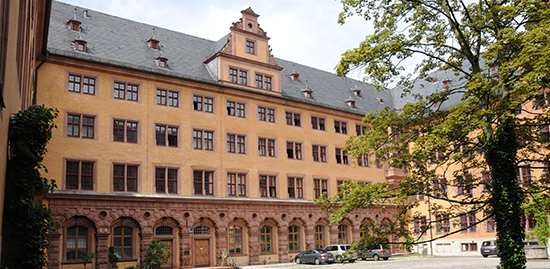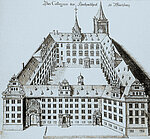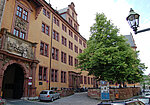Old University

Old University
The origin of the University of Würzburg
In 1582, the University of Würzburg was founded by Julius Echter von Mespelbrunn in a successful second attempt after the initial founding in 1402. The Prince-Bishop of Würzburg ordained that a monumental building should be constructed for his university together with a university church. This building can still be admired today as an architectural jewel of Würzburg’s city center.
The Old University of Würzburg is surrounded by three streets – Neubaustraße, Schönthalstraße and Domerschulstraße. Today, it appears much as it did originally when it was built between 1582 and 1591 on the order of Prince-Bishop Julius Echter. At that time, the massive Renaissance building afforded enough space for all university activities. Today, only the Faculty of Law is located in the Old University. The former university church, the so-called Neubaukirche (Newly Built Church), serves as a location for hosting university functions and events.
The cornerstone of the Old University was laid on June 11, 1582 on the premises of the abandoned Benedictine Monastery of St. Ulrich on the southern edge of the historic city center. Echter had the remainder of the monastery torn down to create space for the expansive university building. The construction plans were submitted by Georg Robin (1522-1592), an architect from the Electorate of Mainz. He proposed a four-story building surrounding an almost square courtyard, enclosed to the south by the university church.
Completed in 1585, the east wing was constructed first and contained the seminary. Next, the north wing was built with lecture halls and office rooms, followed by the west wing with a large assembly hall, ballrooms, lecture halls, and rooms for the rector. The construction of the university church started in 1586. With the consecration of the church in 1591, Echter solemnly concluded the construction of his university.
Relief over the entrance to the courtyard
Echter had himself immortalized in a relief set over the Renaissance entrance to the courtyard. It shows the “Descent of the Holy Spirit on Maria and the apostles”; the Prince-Bishop is kneeling in the foreground of the representation. Three sculptors worked on the relief successively. Erhard Barg, from the town of Schwäbisch Hall, inserted “Science” and “Diligence” as allegorical figures in the relief. Johann von Beundum created the apostles and Paulus Michel depicted the Prince-Bishop.
Lectures in 1604
What was taught at the university during its first years is not known in detail. The oldest surviving course catalogs and syllabi can be traced back to the period between 1604 and 1609. At the Faculty of Philosophy, for instance, the documents list classical languages, grammar, rhetoric, and dialectics as subjects in the curriculum. Each student had to take these subjects as a foundation to their studies.
Shortly after its founding, an average of 150 to 210 students enrolled at the university each year. When Würzburg was under Swedish rule from 1631 to 1634 during the Thirty Years’ War, student enrollment ceased: Students and professors fled as the Prince-Bishop had done himself. However, students began to return to the university as early as 1636. In the early 1650s, shortly after the war, student enrollment rose to 220 again. With this number of students, the University of Würzburg ranked in the middle among the universities of the time.
University library since 1617
Julius Echter, the founder of the university, died in 1617. Two years after his death, a university library was established. His successor, Prince-Bishop Johann Gottfried von Aschhausen, ordered the purchase of a collection of books in 1619 to set up a library in the Old University building.
Almost 200 years later – from 1803 onwards – the collection grew dramatically in size: Due to the confiscation of clerical property during secularization, the library received numerous books, including valuable manuscripts from the cathedral library and monasteries. In 1806, the library boasted over 25,500 volumes.
Instruction in German
During the 18th century, an average of 200 to 300 students enrolled at the University of Würzburg each year. The teaching staff consisted of approximately 40 people. Most of the students were enrolled in the Faculty of Philosophy, though some studied theology and a few medicine. Prince-Bishop Karl von Schönborn (term of office 1729-1746) was the first to allow non-Catholic students into the university. He introduced German as the language of instruction; previously, the lessons were given in Latin.
Lack of space becomes an issue
In the middle of the 19th century, the university really began to flourish. One of the reasons for this was the boom in natural sciences and medicine. In 1854, the number of students reached its first peak with 818 students and Würzburg’s student population surpassed that of the more famous universities of Jena, Halle, Göttingen and Heidelberg in number. It further rose to 1,028 in 1876 and to 1,624 in 1888.
Slowly but surely, the Old University was becoming too small to accommodate the growing student population. A new building site was found in the North of the city at the Pleicherwall, the location of a former rampart. There, the removal of the fortifications had created some space for the expansion of the city and the university. At Pleicherwall, the university built a number of institutes and hospitals for the emerging natural sciences and medicine.
New building in Sanderring Street eases space issues
The new institutes and hospitals did not solve the space issue at the Old University. The building contained not only the classrooms, but also the natural science and historic art collections, accommodation for the rector and professors, rooms for administrative business, as well as the library rooms. Around 1870, this led to the proposal of erecting a new building for the library. This, however, was rejected and the decision was made to build a new main building on today’s Sanderring Street. It was inaugurated in 1896.
World War II and reconstruction
At the end of the Second World War, the Old University and the Neubaukirche (Newly Built Church) were severely damaged in a British bombing raid on 16 March 1945. On that day, the university library lost about 80 percent of its collections. As early as in the summer of 1945, lecturers and students took part in removing the rubble from the destroyed university buildings and started the reconstruction. In the summer of 1946, student enrollment reached 1,279 again.
In the 1950s, the Old University was reconstructed as best as possible with only a small budget in order to make it ready for re-opening. In the following years, the Martin-von-Wagner Museum with part of the university collections was transferred from the Old University to the south wing of the Residence (1963). In 1981, the university library moved to its new building on Hubland Campus.
Full restoration completed in 2002
Starting in 1989, a 7.3 million euro full restoration was completed without interrupting university operations. Destroyed parts of the building were reconstructed and new built-in components were made with historical materials in the original style to preserve the historic design of an important building in the Würzburg cityscape. The restoration was completed in 2002.
Sources: “Kleine Geschichte der Würzburger Universität” (A Short History of the University of Würzburg) by Peter Süß, university archive, state building authority, university library
Robert Emmerich









